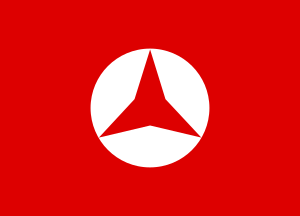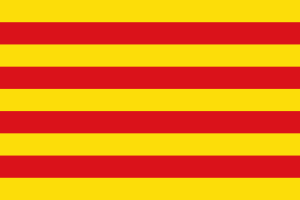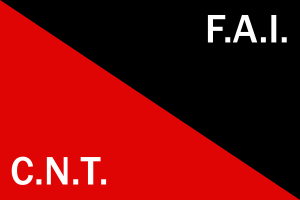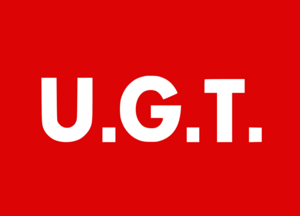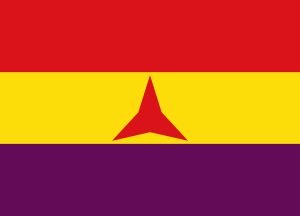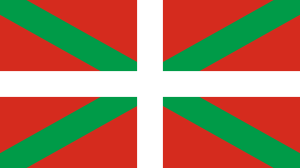Republican faction (Spanish Civil War) facts for kids
Quick facts for kids Republican faction |
|
|---|---|
| Bando republicano | |
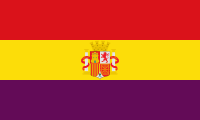
Flag of the Second Spanish Republic
|
|
| Dates of operation | 17 July 1936 – 1 April 1939 |
| Ideology | Spanish republicanism Anti-fascism Secularism Progressivism Anarchism (Spanish)
Communism Liberalism (Spanish) Libertarian socialism Nationalism Regionalism Social democracy |
| Political position | Centre to Left-wing (majority) |
| Allies | |
| Opponents |
|
|
|
|
The Republican faction (known in Spanish as Bando republicano) was one of the main sides in the Spanish Civil War, which lasted from 1936 to 1939. This group supported the official government of Spain, called the Second Spanish Republic, against a military uprising. People also called them the Loyalist faction or the Government faction because they were loyal to the existing government.
The members and supporters of this side often called themselves Republicans. Their opponents, however, sometimes called them Rojos (which means "Reds"). This was because the Republican side included many groups with left-leaning ideas, like communists and anarchists, and they received support from the Soviet Union. At the start of the war, the Republicans had many more fighters than the Nationalists, but this advantage became smaller over time.
Contents
Who Fought for the Republicans?
Many different groups and people joined the Republican side. They all shared the goal of defending the Spanish Republic, even if they had different political ideas.
Political Groups and Parties
The Popular Front
The Popular Front was a big group of different political parties that worked together. These parties included socialists, communists, and other left-wing groups. They formed a government before the war started and were the main political force supporting the Republic.
Regional Groups
Some groups from specific regions of Spain also supported the Republic. They wanted more self-rule for their areas.
Basque Groups
- Basque nationalism: People who wanted the Basque Country to have more independence.
- Basque Nationalist Party: A political party in the Basque region.
- Basque Nationalist Action: Another Basque political group.
Catalan Groups
- Government of Catalonia: The regional government of Catalonia, which supported the Republic.
- Catalan nationalism: People who wanted Catalonia to have more self-rule.
- Republican Left of Catalonia: A major political party in Catalonia.
- Catalan Action: Another Catalan political group.
- Estat Català: A Catalan nationalist party.
Worker Unions
Large worker unions played a very important role on the Republican side. Their members often formed militias to fight.
CNT/FAI
The CNT (National Confederation of Labor) was a large anarcho-syndicalist trade union. It worked closely with the FAI (Iberian Anarchist Federation), an anarchist group. They were very powerful, especially in Catalonia and Aragon.
UGT
The UGT (General Union of Workers) was another major trade union, closely linked to the socialist party.
Military Forces
People's Republican Army
In October 1936, the Republican government started to organize its military forces better. They created the People's Republican Army (Ejército Popular de la República, EPR). This army included soldiers who stayed loyal to the Republic and also many militia members who joined the new structure.
Other Military Branches
- Spanish Republican Navy: The navy that remained loyal to the Republic.
- Carabineros: A law enforcement unit that mostly supported the Republic.
- Civil Guard: Parts of this police force stayed loyal and were later renamed the National Republican Guard.
- Guardias de Asalto: An urban police force that largely supported the Republic.
- Spanish Republican Air Force: The air force of the Republic.
International Brigades and Other Volunteers
Many people from other countries came to Spain to fight for the Republican side. These volunteers, often socialists, communists, or anarchists, came from 52 different nations.
Most of them, about 32,000 men and women, joined the International Brigades. These brigades were organized with help from the Comintern, a group that supported communist movements worldwide. About 3,000 other foreign volunteers fought with anarchist groups like the CNT or with anti-Stalinist Marxist groups like the POUM. Famous writer George Orwell was one of those who fought with the POUM.
Regional Armies
Some regions also had their own armies that fought for the Republic:
- Basque Army
- Basque Auxiliary Navy
- People's Army of Catalonia
Foreign Support for the Republicans
The Republican side received help from a few countries, mainly the Soviet Union and Mexico.
Mexico
The government of Mexico openly supported the Spanish Republic. Mexico's President Lázaro Cárdenas saw the Spanish Civil War as similar to Mexico's own revolution. Mexico provided some money and a small number of American-made aircraft. This support was important for the Republic's morale, especially since many other Latin American countries favored the Nationalists.
Soviet Union
The Soviet Union was the main source of weapons and supplies for the Republicans. They sent planes, tanks, and artillery. Even though there was an international agreement not to interfere, the Soviet Union secretly sent arms to the Republic.
Soviet leader Joseph Stalin wanted to help the Republic but tried to keep it secret. He even created a special military section for this operation. Many of the weapons sent were older models, but some modern tanks and fighter planes were also supplied. The Republic paid for these weapons using a large part of Spain's gold reserves. The Soviet Union also sent military advisers to Spain, and Soviet volunteers often operated the tanks and aircraft.
Mixed Support: France
France's position towards the Spanish Republic was complicated and changed over time. The French government did not send direct support to the Republicans. The French Prime Minister, Léon Blum, was sympathetic to the Republic, but the French President, Albert Lebrun, was against direct help.
France worried that if the Nationalists won, Spain might become an ally of Nazi Germany and Fascist Italy, which could be a threat to France. However, other countries, especially Britain, convinced France not to send arms. In August 1936, France, the UK, and Italy signed a "Non-Intervention" agreement, promising not to get involved in the war.
Despite this, the French government did secretly provide some older aircraft to the Spanish Republicans for a few months in late 1936. These planes were often not very effective. Towards the end of the war, many Republican ships and soldiers who escaped to France were held in internment camps. Some of these Spanish Republicans later joined the Allied armies to fight against the Axis powers in World War II.
See also
 In Spanish: Bando republicano para niños
In Spanish: Bando republicano para niños


